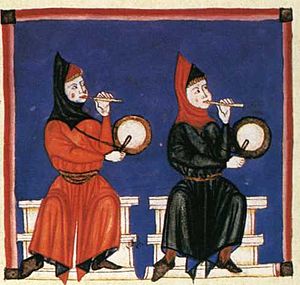Tabor facts for kids
A tabor (sometimes called a tabret) is a small, portable snare drum. You can play it with just one hand! The word "tabor" comes from a Latin word that simply means "drum."
For a long time, the tabor has been used in different ways. It was often played in the military as a marching instrument to keep soldiers in step. People also used it in parades and for dancing.
Contents
What is a Tabor?
A tabor is a type of percussion instrument. It's a drum that is usually small enough to be carried easily. It has a drumhead on one or both sides, and often has snares. Snares are strings or wires stretched across the bottom head that vibrate when the top head is hit, giving the drum its buzzing sound.
History of the Tabor
The tabor has a very long history! Drums like the tabor have been around for thousands of years in many different cultures. In Europe, the tabor became very popular during the Middle Ages and the Renaissance.
People often played the tabor with another instrument called a pipe. The pipe is a small flute-like instrument that you can play with one hand. This way, a single musician could play both the melody (on the pipe) and the rhythm (on the tabor) at the same time! This combination was very common for dancing and street performances.
How is the Tabor Played?
Playing the tabor is quite unique because it's designed to be played with one hand. The musician usually holds the drum with their arm or wrist. They then use a drumstick held in the same hand to hit the drumhead.
The other hand is free to play a different instrument, most often a pipe. This skill requires a lot of practice to coordinate both instruments at once. The tabor provides a steady beat, while the pipe plays the tune.
Uses of the Tabor Drum
The tabor was used for many things in the past:
- Dancing: It was a popular instrument for providing music for folk dances.
- Parades and Festivals: Its loud, clear sound made it great for outdoor events.
- Military: Soldiers used it to help them march in time.
- Street Performances: Musicians would play the pipe and tabor to entertain people in towns and villages.
Even today, you might see tabors used in historical music groups or at Renaissance fairs.
See also
 In Spanish: Tabor para niños
In Spanish: Tabor para niños


